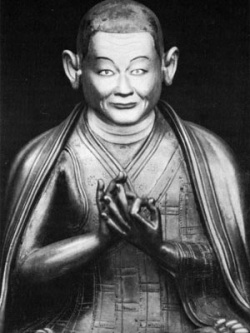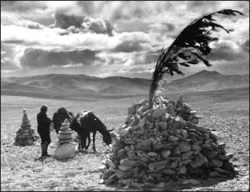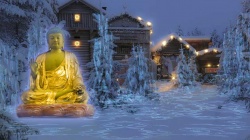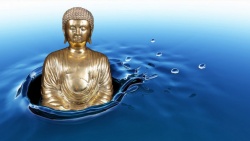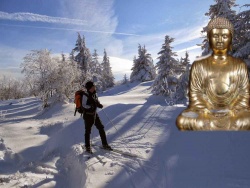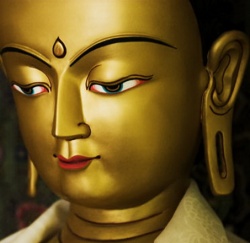Difference between revisions of "1st Karmapa"
| (15 intermediate revisions by 2 users not shown) | |||
| Line 1: | Line 1: | ||
| − | [[File:Karmapa1.jpg|thumb|right|250px|Düsum Khyenpa 1st Karmapa]] | + | [[File:Karmapa1.jpg|thumb|right|250px|Düsum Khyenpa 1st Karmapa]]<nomobile>{{DisplayImages|3351|4351|2011|3902|1525}}</nomobile> |
| − | |||
| − | |||
| − | |||
| − | |||
| − | |||
| − | |||
| − | |||
| − | |||
| − | |||
| − | |||
| − | |||
| − | |||
| − | |||
| + | [[Düsum Khyenpa]] ([[Tibetan]]: {{BigTibetan|[[དུས་གསུམ་མཁྱེན་པ་]]}}, [[Wylie]]: [[dus gsum mkhyen pa]]) (1110–1193) was the [[1st Gyalwa Karmapa]], {{Wiki|head}} of the [[Karma Kagyu]] ([[ka rma bka’ brgyud]]) school of [[Tibetan Buddhism]]. | ||
| + | |||
| + | [[Dusum Khyenpa]] or [[Khyenpa]] or [[Khenpa]] (1110-1193) ([[Du-song Qian-ba Da-fa-wang]]): [[Tibetan]] [[Dharma King]] and [[disciple]] of [[Gampopa]] who became the [[First Karmapa]]. | ||
| + | |||
| + | [[Düsum Khyenpa]] literally means "[[Knower of the Three times]]" (or {{Wiki|past}}, {{Wiki|present}} and {{Wiki|future}}). | ||
| + | |||
| + | It was given to him to refer to [[knowledge]] of the three [[forms]] of [[time]] he gained at [[enlightenment]] [[including]] the "timeless [[time]]" of [[enlightened]] [[awareness]]. | ||
| + | |||
| + | He was born to a devout [[family]] of [[Buddhist]] practitioners in Teshö in eastern [[Tibet]] and was called [[Gephel]] as a child. | ||
| + | |||
| + | He first studied with his [[father]] and then continued {{Wiki|training}} with other [[Buddhist]] [[teachers]] in the region. | ||
| + | |||
| + | He was a gifted child who studied and practiced [[Dharma]] intently from an early age. | ||
| + | |||
| + | Already quite learned by the age of twenty, he became a [[monk]] and studied the [[sutras]] and [[tantra]] intensively for a further ten years. | ||
| + | |||
| + | At thirty, he went to [[Daklha Gampo]] -- [[Gampopa's]] monastery—to receive teachings from him. | ||
| + | |||
| + | Although this was a historic meeting of two great [[Buddhist]] [[bodhisattva]]s [[emanating]] on [[Earth]] with a profound {{Wiki|purpose}}, [[Gampopa]] nevertheless first made [[Dusum Khyenpa]] train formally in the [[foundation practices]] of the [[Kadampa tradition]] and, following that, in the {{Wiki|general}} [[philosophy]] of the [[sutras]]. | ||
| + | |||
| + | This set a fine example for all {{Wiki|future}} [[Kagyu]] followers and showed the need for the correct basis of [[knowledge]] even when—especially when—one does the most {{Wiki|powerful}} of [[Vajrayana practices]]. | ||
| + | |||
| + | The [[first Karmapa]] received [[empowerment]]s and [[instruction]] in the [[Hevajra tantra]] and spent four years in strict [[retreat]], {{Wiki|training}} in the [[peaceful]] stability ([[shamatha]]) and profound [[insight]] ([[vipaśyanā]]) aspects of [[meditation]]. | ||
| + | |||
| + | He then received the full [[transmission]] of the inner instructions of the [[Kagyu tradition]]. | ||
| + | |||
| + | In nine days he absorbed what [[Naropa]] had received over 12 years from [[Tilopa]]. | ||
| + | |||
| + | [[Rechungpa]], the '[[moon-like disciple of Milarepa]], also instructed him, principally in the [[Six Yogas of Naropa]]. | ||
| + | |||
| + | His [[attainment]] in one of these -- [[tummo]], [[inner-heat]]—was particularly boosted by his [[own]] natural [[compassion]] and produced rapid results. Following his [[teacher's]] [[instruction]] he then went away to [[meditate]]. | ||
| + | |||
| + | |||
| + | |||
| + | [[Gampopa]] eventually [[died]] and [[Dusum Khyenpa]] returned to [[Daklha Gampo]] to {{Wiki|honor}} his {{Wiki|remains}}. | ||
| + | |||
| + | He had a {{Wiki|powerful}} [[vision]] of his [[teacher]] and knew that it was [[time]] to implement one of his final instructions: to go to the place where he would achieve [[enlightenment]]—[[Kampo Kangra]]—and there to [[practice]] [[mahamudra]]. | ||
| + | |||
| + | He promised that he would [[live]] until the age of 84, in [[order]] to {{Wiki|benefit}} the [[Dharma]]. | ||
| + | |||
| + | He achieved [[enlightenment]] at the age of fifty, while practicing [[dream yoga]]. | ||
| + | |||
| + | He had a [[vision]] at that [[time]] of the [[celestial]] [[beings]] ([[dakini]]s) [[offering]] him a [[vajra]] {{Wiki|crown}} woven from their [[hair]]. | ||
| + | |||
| + | His [[name]]—[[Dusum Khyenpa]]—means '[[Knower of the Past, Present and Future]]', referring to the total [[lucidity]] he [[attained]] at [[enlightenment]], [[giving]] him [[knowledge]] of the three modes of [[time]], and the 'timeless [[time]]' of [[enlightened]] [[awareness]]. | ||
| + | |||
| + | |||
| + | |||
| + | From then onwards his [[teaching]] [[activity]] was intense. | ||
| + | |||
| + | At the age of 58 he founded a [[monastery]] at [[Kampo Nenang]]. | ||
| + | |||
| + | He later established an important seat at [[Karma Gon Monastery]] in eastern [[Tibet]] and, at the age of 74, another seat at [[Tsurphu]] in {{Wiki|central}} [[Tibet]], in the valley of the [[Tolung]], which feeds into the [[Brahmaputra]]. | ||
| + | |||
| + | |||
| + | It is [[interesting]] to note, in the [[light]] of the [[16th Karmapa's]] {{Wiki|prediction}} [[letter]], that the [[abbot]] of the [[Buddhist]] [[monastery]] at [[Bodh Gaya]], in [[India]], the place of the [[Buddha's]] [[enlightenment]], sent a [[conch shell]] to [[Dusum Khyenpa]] at [[Tsurphu]], as a token of the latter's significance for [[buddhadharma]]. | ||
| + | |||
| + | This [[conch shell]] [[symbolism]] is found in many stories of the sixteen [[Karmapas]]. | ||
| + | |||
| + | |||
| + | The [[first Karmapa]], [[Dusum Khyenpa]], made predictions about {{Wiki|future}} [[Karmapas]]. In particular, he was the [[first Karmapa]] to {{Wiki|present}} a {{Wiki|prediction}} [[letter]] detailing his {{Wiki|future}} [[incarnation]]. | ||
| + | |||
| + | He gave it to his main [[disciple]], [[Drogon Rechen]], predecessor of the [[Tai Situpa]] line (they were only called [[Tai Situ]] after this title was conferred by the {{Wiki|Chinese}} [[emperor]] in the early 15th century). | ||
| + | |||
| + | He [[died]] at the age of 84, as predicted. His [[heart]] was found intact in the [[funeral]] pyre and some of his remaining {{Wiki|bones}} bore [[self]] [[manifesting]] [[symbols]] or [[simulacra]] of [[Buddhas]]. | ||
| + | |||
| + | (The similarities with the passing of the [[16th Karmapa]] are remarkable.) | ||
| + | |||
| + | Among his other main [[disciples]] were [[Tak-lungpa]], founder of the [[Ta-lung Kagyu]], [[Tsangpa Gyare]], founder of the [[Drukpa Kagyu]] (now widespread in [[Bhutan]]) and [[Lama]] [[Khadampa Deshek[[, founder of the [[Katok Nyingma lineage]]. | ||
| + | |||
| + | |||
| + | |||
| + | The forefathers in the [[Kagyu lineage]] are known as the "[[Golden Rosary]]." | ||
| + | |||
| + | The [[lineage]] of the [[Kagyu]] emphasizes the continuity of [[oral instructions]] passed on from [[master]] to [[student]]. | ||
| + | |||
| + | The [[principal]] [[student]] who held the [[lineage of the Golden Rosary]] from the [[First Karmapa]] was [[Drogon Rechen]]. | ||
| + | |||
| + | An ink and gouache drawing of [[Düsum Khyenpa]] was found in a statue of the [[Buddha]] and is in the [[Victoria and Albert Museum]]. | ||
| + | |||
| + | |||
| + | {{R}} | ||
| + | [[Category:Buddhist Terms]] | ||
| + | [[Category:Buddhism]] | ||
| + | [[Category:Tibetan Buddhism]] | ||
| + | [[Category:Karma Kagyu]] | ||
| + | [[Category:1st Karmapa]] | ||
[[Category:Tibetan Buddhist Teachers|Karmapa]] | [[Category:Tibetan Buddhist Teachers|Karmapa]] | ||
| − | |||
| − | __NOTOC__ | + | |
| + | __NOTOC__{{BuddhismbyNumber}} | ||
Latest revision as of 12:24, 29 December 2023
Düsum Khyenpa (Tibetan: དུས་གསུམ་མཁྱེན་པ་, Wylie: dus gsum mkhyen pa) (1110–1193) was the 1st Gyalwa Karmapa, head of the Karma Kagyu (ka rma bka’ brgyud) school of Tibetan Buddhism.
Dusum Khyenpa or Khyenpa or Khenpa (1110-1193) (Du-song Qian-ba Da-fa-wang): Tibetan Dharma King and disciple of Gampopa who became the First Karmapa.
Düsum Khyenpa literally means "Knower of the Three times" (or past, present and future).
It was given to him to refer to knowledge of the three forms of time he gained at enlightenment including the "timeless time" of enlightened awareness.
He was born to a devout family of Buddhist practitioners in Teshö in eastern Tibet and was called Gephel as a child.
He first studied with his father and then continued training with other Buddhist teachers in the region.
He was a gifted child who studied and practiced Dharma intently from an early age.
Already quite learned by the age of twenty, he became a monk and studied the sutras and tantra intensively for a further ten years.
At thirty, he went to Daklha Gampo -- Gampopa's monastery—to receive teachings from him.
Although this was a historic meeting of two great Buddhist bodhisattvas emanating on Earth with a profound purpose, Gampopa nevertheless first made Dusum Khyenpa train formally in the foundation practices of the Kadampa tradition and, following that, in the general philosophy of the sutras.
This set a fine example for all future Kagyu followers and showed the need for the correct basis of knowledge even when—especially when—one does the most powerful of Vajrayana practices.
The first Karmapa received empowerments and instruction in the Hevajra tantra and spent four years in strict retreat, training in the peaceful stability (shamatha) and profound insight (vipaśyanā) aspects of meditation.
He then received the full transmission of the inner instructions of the Kagyu tradition.
In nine days he absorbed what Naropa had received over 12 years from Tilopa.
Rechungpa, the 'moon-like disciple of Milarepa, also instructed him, principally in the Six Yogas of Naropa.
His attainment in one of these -- tummo, inner-heat—was particularly boosted by his own natural compassion and produced rapid results. Following his teacher's instruction he then went away to meditate.
Gampopa eventually died and Dusum Khyenpa returned to Daklha Gampo to honor his remains.
He had a powerful vision of his teacher and knew that it was time to implement one of his final instructions: to go to the place where he would achieve enlightenment—Kampo Kangra—and there to practice mahamudra.
He promised that he would live until the age of 84, in order to benefit the Dharma.
He achieved enlightenment at the age of fifty, while practicing dream yoga.
He had a vision at that time of the celestial beings (dakinis) offering him a vajra crown woven from their hair.
His name—Dusum Khyenpa—means 'Knower of the Past, Present and Future', referring to the total lucidity he attained at enlightenment, giving him knowledge of the three modes of time, and the 'timeless time' of enlightened awareness.
From then onwards his teaching activity was intense.
At the age of 58 he founded a monastery at Kampo Nenang.
He later established an important seat at Karma Gon Monastery in eastern Tibet and, at the age of 74, another seat at Tsurphu in central Tibet, in the valley of the Tolung, which feeds into the Brahmaputra.
It is interesting to note, in the light of the 16th Karmapa's prediction letter, that the abbot of the Buddhist monastery at Bodh Gaya, in India, the place of the Buddha's enlightenment, sent a conch shell to Dusum Khyenpa at Tsurphu, as a token of the latter's significance for buddhadharma.
This conch shell symbolism is found in many stories of the sixteen Karmapas.
The first Karmapa, Dusum Khyenpa, made predictions about future Karmapas. In particular, he was the first Karmapa to present a prediction letter detailing his future incarnation.
He gave it to his main disciple, Drogon Rechen, predecessor of the Tai Situpa line (they were only called Tai Situ after this title was conferred by the Chinese emperor in the early 15th century).
He died at the age of 84, as predicted. His heart was found intact in the funeral pyre and some of his remaining bones bore self manifesting symbols or simulacra of Buddhas.
(The similarities with the passing of the 16th Karmapa are remarkable.)
Among his other main disciples were Tak-lungpa, founder of the Ta-lung Kagyu, Tsangpa Gyare, founder of the Drukpa Kagyu (now widespread in Bhutan) and Lama [[Khadampa Deshek[[, founder of the Katok Nyingma lineage.
The forefathers in the Kagyu lineage are known as the "Golden Rosary."
The lineage of the Kagyu emphasizes the continuity of oral instructions passed on from master to student.
The principal student who held the lineage of the Golden Rosary from the First Karmapa was Drogon Rechen.
An ink and gouache drawing of Düsum Khyenpa was found in a statue of the Buddha and is in the Victoria and Albert Museum.
